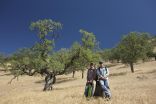(Press-News.org) Computers are good at identifying patterns in huge data sets. Humans, by contrast, are good at inferring patterns from just a few examples.
In a paper appearing at the Neural Information Processing Society's conference next week, MIT researchers present a new system that bridges these two ways of processing information, so that humans and computers can collaborate to make better decisions.
The system learns to make judgments by crunching data but distills what it learns into simple examples. In experiments, human subjects using the system were more than 20 percent better at classification tasks than those using a similar system based on existing algorithms.
"In this work, we were looking at whether we could augment a machine-learning technique so that it supported people in performing recognition-primed decision-making," says Julie Shah, an assistant professor of aeronautics and astronautics at MIT and a co-author on the new paper. "That's the type of decision-making people do when they make tactical decisions -- like in fire crews or field operations. When they're presented with a new scenario, they don't do search the way machines do. They try to match their current scenario with examples from their previous experience, and then they think, 'OK, that worked in a previous scenario,' and they adapt it to the new scenario."
In particular, Shah and her colleagues -- her student Been Kim, whose PhD thesis is the basis of the new paper, and Cynthia Rudin, an associate professor of statistics at the MIT Sloan School of Management -- were trying to augment a type of machine learning known as "unsupervised."
In supervised machine learning, a computer is fed a slew of training data that's been labeled by humans and tries to find correlations -- say, those visual features that occur most frequently in images labeled "car." In unsupervised machine learning, on the other hand, the computer simply looks for commonalities in unstructured data. The result is a set of data clusters whose members are in some way related, but it may not be obvious how.
Balancing act
The most common example of unsupervised machine learning is what's known as topic modeling, in which a system clusters documents together according to their most characteristic words. Since the data is unlabeled, the system can't actually deduce the topics of the documents. But a human reviewing its output would conclude that, for instance, the documents typified by the words "jurisprudence" and "appellate" are legal documents, while those typified by "tonality" and "harmony" are music-theory papers.
The MIT researchers made two major modifications to the type of algorithm commonly used in unsupervised learning. The first is that the clustering was based not only on data items' shared features, but also on their similarity to some representative example, which the researchers dubbed a "prototype."
The other is that rather than simply ranking shared features according to importance, the way a topic-modeling algorithm might, the new algorithm tries to winnow the list of features down to a representative set, which the researchers dubbed a "subspace." To that end, the algorithm imposes a penalty on subspaces that grow too large. So when it's creating its data clusters, it has to balance three sometimes-competing objectives: similarity to prototype, subspace size, and clear demarcations between clusters.
"You have to pick a good prototype to describe a good subspace," Kim explains. "At the same time, you have to pick the right subspace such that the prototype makes sense. So you're doing it all simultaneously."
The researchers' first step was to test their new algorithm on a few classic machine-learning tasks, to make sure that the added constraints didn't impair its performance. They found that on most tasks, it performed as well as its precursor, and on a few, it actually performed better. Shah believes that that could be because the prototype constraint prevents the algorithm from assembling feature lists that contain internal contradictions.
Suppose, for instance, that an unsupervised-learning algorithm was trying to characterize voters in a population. A plurality of the voters might be registered as Democrats, but a plurality of Republicans may have voted in the last primary. The conventional algorithm might then describe the typical voter as a registered Democrat who voted in the last Republican primary. The prototype constraint makes that kind of result very unlikely, since no single voter would match its characterization.
Road test
Next, the researchers conducted a set of experiments to determine whether prototype-based machine learning could actually improve human decision-making. Kim culled a set of recipes from an online database in which they had already been assigned categories -- such as chili, pasta, and brownies -- and distilled them to just their ingredient lists. Then she fed the lists to both a conventional topic-modeling algorithm and the new, prototype-constrained algorithm.
For each category, the new algorithm found a representative example, while the conventional algorithm produced a list of commonly occurring ingredients. Twenty-four subjects were then given 16 new ingredient lists each. Some of the lists were generated by the new algorithm and some by the conventional algorithm, and the assignment was random. With lists produced by the new algorithm, subjects were successful 86 percent of the time, while with lists produced by the conventional algorithm, they were successful 71 percent of the time.
INFORMATION:
Written by Larry Hardesty, MIT News Office
Related links
ARCHIVE: Collaborative learning--for robots
ARCHIVE: Humans and robots work better together following cross-training
Study results that challenge the idea that bilingual speakers have a cognitive advantage are less likely to be published than those that support the bilingual-advantage theory, according to new research published in Psychological Science, a journal of the Association for Psychological Science. This research suggests that a publication bias in favor of positive results may skew the overall literature on bilingualism and cognitive function.
"Publishing only 'successful' studies means that we do not have access to many valuable studies that could increase our understanding ...
Toronto, Dec. 5, 2014 - The number of children and youth treated for concussions in both emergency departments and physician's offices in Ontario increased significantly between 2003 and 2010, with falls, hockey and skating injuries identified as the leading causes of pediatric concussion, according to a new joint study out of York University and the Institute for Clinical Evaluative Sciences (ICES).
The study," A population-based study of pediatric emergency department and office visits for concussions from 2003 to 2010", published today in the journal Paediatrics & ...
With so much focus on risk factors for disease, we are living in an era of surveillance medicine, in which the emphasis on risk blurs the lines between health and illness, argue researchers at Yale and Syracuse universities in a study published in the December issue of the Journal of Health and Social Behavior.
Co-authors Rene Almeling, assistant professor of sociology at Yale, and Shana Kushner Gadarian, assistant professor of political science at Syracuse University, conducted a nationwide survey of American adults to determine if healthy people react to hypothetical ...
The Ku Klux Klan's failure to defeat the black civil rights moment is well documented, but the group's lesser-known legacy may be its lasting impact on the U.S. political system, according to a paper published in the December issue of the American Sociological Review.
David Cunningham, professor and chair of the Department of Sociology at Brandeis University, Rory McVeigh of the University of Notre Dame and Justin Farrell of Yale University report that KKK activity played a significant role in shifting voters' political party allegiance in the South in the 1960s -- from ...
(NEW YORK - December 5, 2014) A key protein may represent a new way to use the immune system to speed healing and counter inflammatory, infectious and autoimmune diseases, according to study led by researchers at the Icahn School of Medicine at Mount Sinai and published in the December issue of Cell Reports.
The current study results revolve around proteinases, enzymes that break down proteins as part of cellular life. Matrix metalloproteinases or MMPs specifically target the extracellular matrix, the non-cell, structural framework within tissues. Beyond that role, ...
CHICAGO (December 5, 2014): Malnutrition is an important factor predicting long-term survival in older patients undergoing pancreaticoduodenectomy (PD) (commonly called the Whipple procedure) to treat benign tumors and cysts of the pancreas as well as pancreatitis, according to new study results published in the December issue of the Journal of the American College of Surgeons.
"A comprehensive geriatric assessment of elderly patients who are being evaluated for the Whipple procedure is essential," said lead study author Dominic Sanford, MD, MPHS, a general surgery ...
Super Typhoon Hagupit is forecast to make landfall in the eastern Philippines bringing heavy rainfall, damaging winds and storm surge. NASA/JAXA's TRMM satellite and the RapidScat instrument provided rainfall and wind data, while NASA-NOAA's Suomi NPP satellite provided a visible image of the storm. In the Philippines, Hagupit is known locally as "Typhoon Ruby."
The Tropical Rainfall Measuring Mission or TRMM satellite caught a good view of Super Typhoon Hagupit on December 4, 2014 at 1721 UTC (12:21 p.m. EST) when its sustained winds were estimated at over 145 knots ...
ABBOTT PARK, Ill., Dec. 4, 2014 - Even in food-abundant industrialized countries like the U.S., an alarming number of people, particularly seniors, are in a state of diseased-associated malnutrition . Because of the impact on patient health, disease-associated malnutrition imposes a significant economic burden on society of $157 billion per year, according to new research published in a supplemental issue of the Journal of Parenteral and Enteral Nutrition (JPEN) and supported by Abbott .
Researchers looked at malnutrition across eight specific diseases* and evaluated ...
(Salt Lake City) --How can people who are dependent on prescription opioids reduce their cravings? Learn to enjoy other aspects of their lives.
That's the key finding in a new study published in the Journal of Behavioral Medicine by Eric L. Garland, associate professor at the University of Utah College of Social Work. Garland and colleagues studied how an intervention program for chronic pain patients called Mindfulness-Oriented Recovery Enhancement (MORE) decreased patients' desire for prescription drugs.
The MORE intervention concentrates on helping people ...
As California finally experiences the arrival of a rain-bearing Pineapple Express this week, two climate scientists from the University of Minnesota and Woods Hole Oceanographic Institution have shown that the drought of 2012-2014 has been the worst in 1,200 years.
Daniel Griffin, an assistant professor in the Department of Geography, Environment and Society at the University of Minnesota, and Kevin Anchukaitis, an assistant scientist at Woods Hole Oceanographic Institution, asked the question, "How unusual is the ongoing California drought?" Watching the severity of ...



